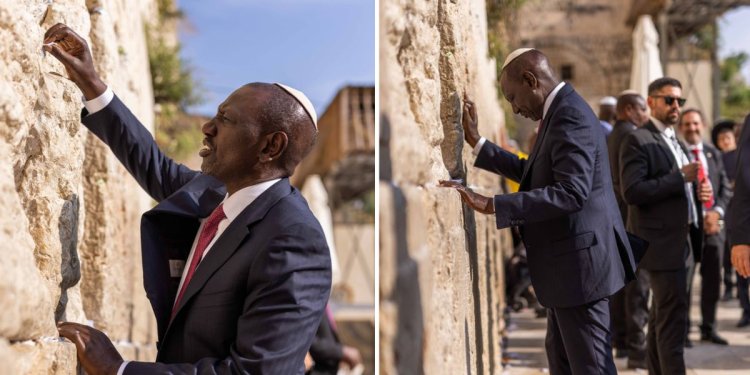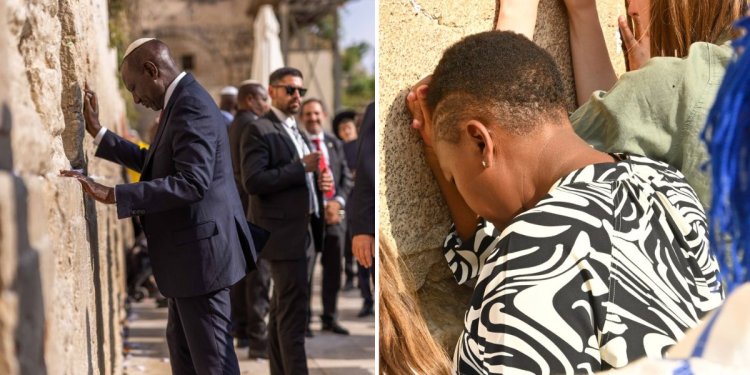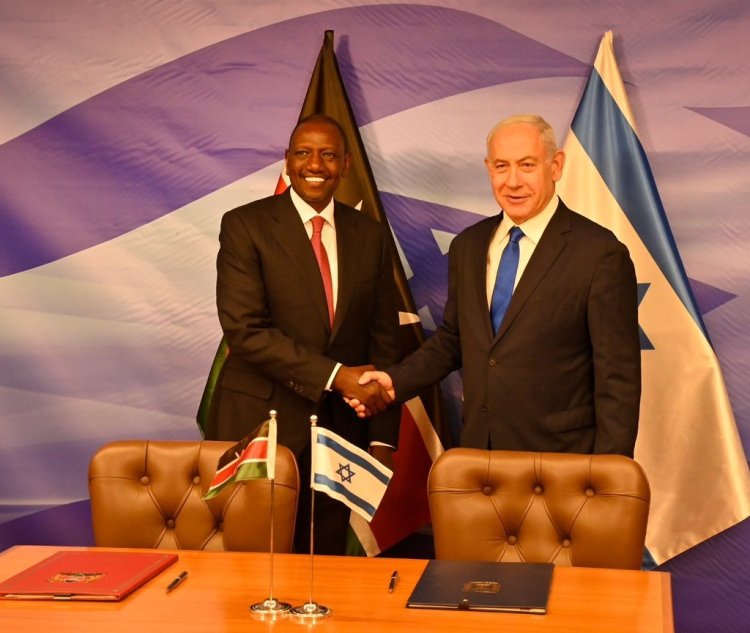Israel Wailing Wall: World's Holiest Place Where Ruto Went To Pray
The Western Wall, also known as the “Wailing Wall” or the “Kotel”, is the most religious site in the world for the Jewish people.

President William Ruto on Tuesday, May 9 prayed at the Western Wall of Jerusalem, Israel commonly referred to by Christians as the Wailing Wall.
He was received by the director of the Western Wall Heritage Foundation, Mordechai Eliav, who narrated the long and enchanting history of the wall, also called the historical site.
Photos shared showed the President in an earnest session of prayer at the wall, where thousands go to have their prayers. He was in the company of his wife, First Lady Rachel Ruto.
“We should never face the isolation and prejudice against our brothers and sisters of the Jewish nation. That we shall be united as a people in peace as one people under God,” Ruto prayed, wishing the Israelites peace and tranquillity.

President William Ruto and First Lady Rachel Ruto pray at the Wailing Wall in Jerusalem, Israel, on May 9, 2023. /PCS
The Head of State was alluding to the prejudice against the Jewish people that led to the Holocaust. More than six million Jews were killed under dictator Adolf Hitler’s rule in Germany and spread to other European countries.
This prejudice acted as a catalyst for the formation of the modern State of Israel, which gained its independence on May 14, 1948.
“Israel is a great place. It is good that I have come to Israel.
“Even though there are difficulties everywhere in the world but coming to the Holy Land is my greatest pleasure,” Ruto told the audience that was with him.
History Of The Wailing Wall
The Western Wall, also known as the “Wailing Wall” or the “Kotel”, is the most religious site in the world for the Jewish people. Located in the Old City of Jerusalem, it is the last remaining outer wall of the ancient Jewish temple and an incredibly important site of modern Israeli history.
Thousands of people of all faiths journey to the wall every year to visit and recite prayers. Traditionally, these prayers are either spoken or written down and placed in the cracks of the wall, which also splits into two sections, one area for males and the other for females.
The term wailing Wailing Wall was coined following the Jews' act of weeping at the site during prayers. However, Jews perceive the phrase Wailing Wall as derogatory.
The wall is a portion of the ancient limestone wall in the Old City of Jerusalem and according to online sources, it plays a crucial role in Judaism due to its proximity to the Temple Mount.
It is the only remains of the retaining wall surrounding the Temple Mount, the site of the First and Second Temples of Jerusalem, held to be uniquely holy by the ancient Jews. The First Temple was destroyed by the Babylonians in 587–586 BCE, and the Second Temple was destroyed by the Romans in 70 CE.
King Herod built this wall in 20 BCE during an expansion of the Second Temple. When the Romans destroyed the temple in 70 CE, the support wall survived.
For hundreds of years, people prayed in the small area of the wall that could be seen. In 1967, following the Six Day War, Israelis dug below the ground of the wall, exposing two more levels, and also cleared the area around the wall to create the Western Wall Plaza that visitors see today.
The Temple Mount has several entry restrictions, hence the Wall is the holiest place where Jews are permitted to pray outside the previous Temple Mount platform, as the presumed site of the Holy of Holies, the most sacred site in the Jewish faith, which lies just behind it.
Raila's Visit to Wailing Wall
The Western Wall is free to visit and is open 24 hours a day, year-round.
Women and men should dress modestly in the Western Wall Plaza. To pray at the wall, women should have their legs and shoulders covered (scarves are provided at the site) while men should cover their heads.
In 2017, opposition leader Raila Odinga also prayed at the Wailing Wall, which he termed a very strong symbol of strength and unity.
“This week, I travelled to The Holy Land to deliver an address on democracy, religion and peace in Africa. While in Jerusalem, I visited the Western Wall. The Western Wall is the pulpit of the Temple of Solomon and is said to have been built over 5,000 years ago.
"This site is sacred to all three Abrahamic religions - Judaism, Islam and Christianity - and to me, it is a very strong symbolism of strength and unity,” Raila said at the time.
Ruto paid a visit to the wall after talks with Israeli Prime Minister Benjamin Netanyahu and his Israel counterpart Isaac Herzog at his residence in Jerusalem in his bid to expand Israel-Kenya cooperation.

President William Ruto shakes hands with Israel Prime Minister Benjamin Netanyahu at his Netanyahu's office in Jerusalem, Israel, on May 9, 2023. /PCS
“We must exploit these opportunities. There is a wide range of exports that deserve to reach the Israeli market,” said Ruto.
He said the absence of direct flights between Kenya and Israel is a “serious impediment” that continues to hamper trade and tourism. Ruto observed that Kenya and Israel possess unique global attractions that can sustain robust growth in tourism.






